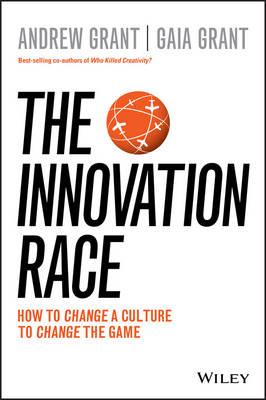 Adapted excerpt from The Innovation Race: How to Change a Culture to Change the Game. By Andrew and Gaia Grant.
Adapted excerpt from The Innovation Race: How to Change a Culture to Change the Game. By Andrew and Gaia Grant.
How is it possible to ignite the imagination, and then to successfully make the transition from imagination to innovation? When we dream up novel concepts, how do we then turn them into practical realities? Making the connection from the initial stage of imagination through to original and useful ideas and finally to full implementation is not easy, but it’s critical for innovation success.
The inventor of the helicopter, Igor Sikorsky, has often quoted Jules Verne as saying, ‘Anything that one man can imagine, another man can make real.’ A lot of ideas that originated in fiction have seeded ideas that have become incredible inventions. Imagine if we could deliberately tap into that creative potential and make the link with possible innovation outcomes – imagine how much that would support the innovation process!
Many people will already be aware of how fiction can prefigure reality, and how creative minds behind Hollywood science fiction stories have imagined inventions before they have happened. Consider how much of what has been imagined by novelists and screenwriters in the past has gone on to be realised in one form or another. If you didn’t already know, Jules Verne, in his books Twenty Thousand Leagues Under the Sea and Clipper of the Clouds, anticipated the invention of the submarine and the helicopter. The rocket and the moon landing were anticipated by H. G. Wells in his novels War of the Worlds (about a Martian invasion) and The First Men in the Moon. Star Trek inspired both the first mobile phone by Motorola and Apple’s QuickTime.
Imagining potential futures is a critical part of the innovation process because it uncovers potential positive and negative consequences to help shape the development of ideas. This enables the innovator not simply to imagine the new ideas or products themselves, but to think through their potential impact. This means exploring a wide range of possibilities, while ensuring that the innovation process is relevant, realistic and responsible.
 A number of companies have already been capitalising on this concept of tapping into the imagination to trigger innovation. Google, Apple and Microsoft have all engaged science fiction writers to help stimulate ideas in design fiction sessions. This term was first popularised by science fiction writer Bruce Sterling in his book Shaping Things in 2005 and was applied in a business context in 2008 by Nokia researcher Julian Bleecker.
A number of companies have already been capitalising on this concept of tapping into the imagination to trigger innovation. Google, Apple and Microsoft have all engaged science fiction writers to help stimulate ideas in design fiction sessions. This term was first popularised by science fiction writer Bruce Sterling in his book Shaping Things in 2005 and was applied in a business context in 2008 by Nokia researcher Julian Bleecker.
Google, Apple and Microsoft have all engaged science fiction writers to help stimulate ideas in design fiction sessions.
Design fiction uses critical and narrative scenarios to imagine and raise questions about possible futures. This process has been used in the development of a domestic robot (by Intel) and of a mixed-reality immersive education desk (through Essex University). It has also been adopted to spark creative thinking around a number of challenges across the world, including entrepreneurship (Canterbury Christchurch Business School), the use of science and technology in business innovation (National Taiwan University), computer security issues (University of Washington), language learning (Shijiazhuang University, China) and community development projects (Leeds and Manchester Universities).
Other corporations have hired authors to create ‘what if’ stories to test new ideas. All these initiatives have helped to activate imagination and the innovation process. Another popular approach we have used in a business setting, the pre-mortem, helps project teams identify potential risks at the outset through a scenario planning approach, so the project can be adjusted and improved at the start rather than autopsied afterwards. But unlike a typical critiquing session, in which project team members are asked what might go wrong, the pre-mortem operates on the assumption that the ‘patient’ (project) has died (failed) and asks what went wrong. The team members’ task is to generate plausible reasons for the project’s ‘failure’.
Researchers have found that this type of prospective hindsight increases the ability to correctly predict future outcomes by 30 per cent. This use of imagination and innovative thinking generates creative new ideas and approaches that may not previously have been considered. We believe that the ‘what if’ process is especially important for purpose-driven innovation, and for ensuring that we consider the social implications of our innovations so they are of benefit for all. This can happen at all stages of the innovation process, from helping to generate the first sparks of an idea at the imagination stage, through to helping to test potential ideas at the implementation stage.
How to ignite the imagination and convert ideas to innovations:
- Think without boundaries when approaching a situation needing new ideas – not in terms of what is possible or what is practical, but in terms of what is ideal and original. Generate wild and apparently implausible ideas to ignite the imagination before zooming in on the best solutions, keeping these phases completely separate to ensure the imagination is best supported.
- Use techniques such as ‘design fiction‘, ‘prototyping fiction’ or ‘pre-mortems’ to help imagine future possibilities and work through to potential outcomes.
- Consider the potential outcomes and implications to ensure ideas are relevant, realistic and responsible – and that the innovation process is purpose-driven. Worth through different ‘what if?’ scenarios.

The Innovation Race
How to Change a Culture to Change the Game
How to create a sustainable culture of innovation - from a unique anthropological and sociological perspective!
How did a motley crew of Aborigines outsmart a highly trained SAS team in a televised survival challenge? What can the traditional cheese rolling race of Italy and the log-rolling race of Papua New Guinea teach us about innovation and progress? And what does this all mean for individuals and organizations that want to innovate today?
Innovation is an essential survival tool. In business it has been found to be a strong indicator of organizational success ...







Comments
No comments